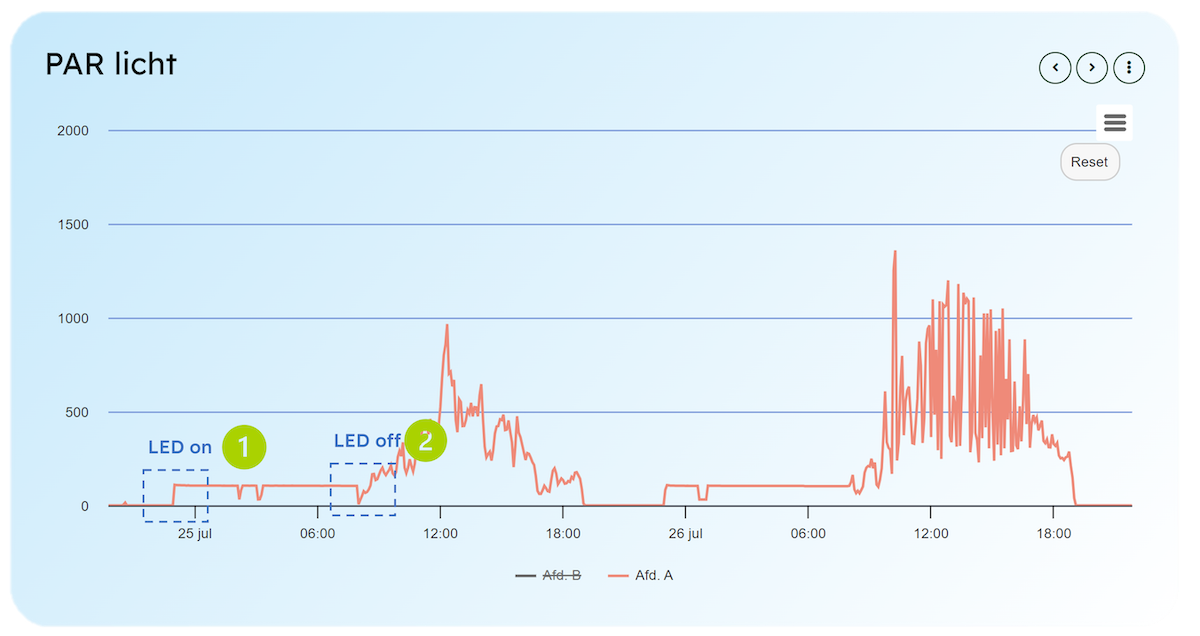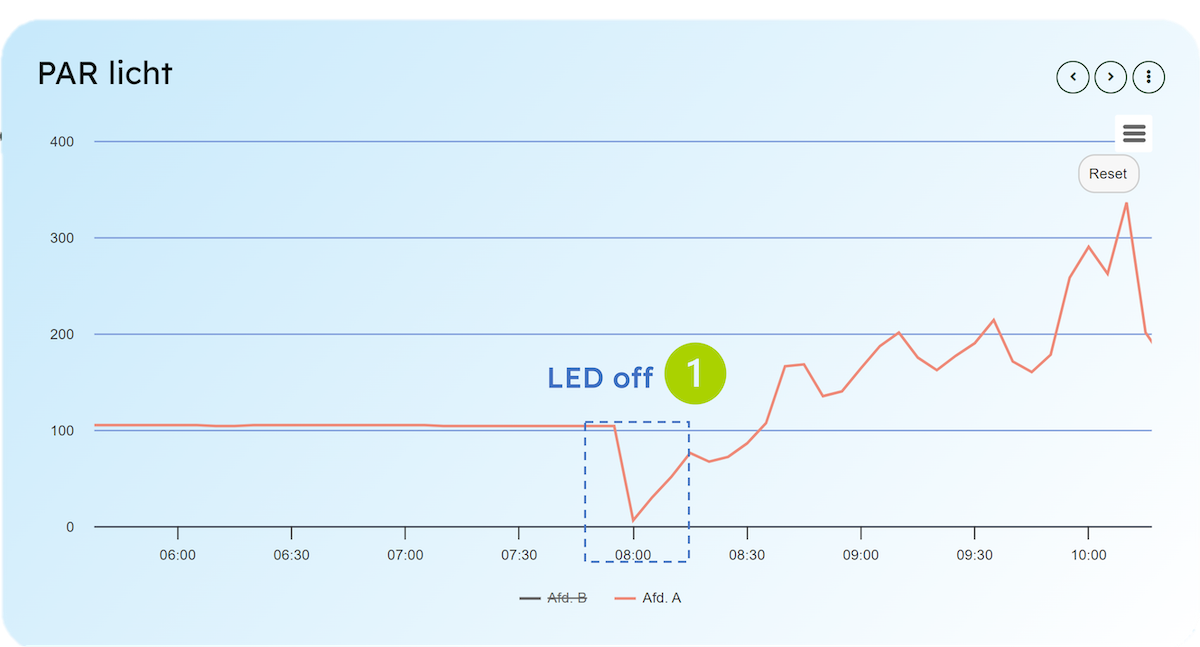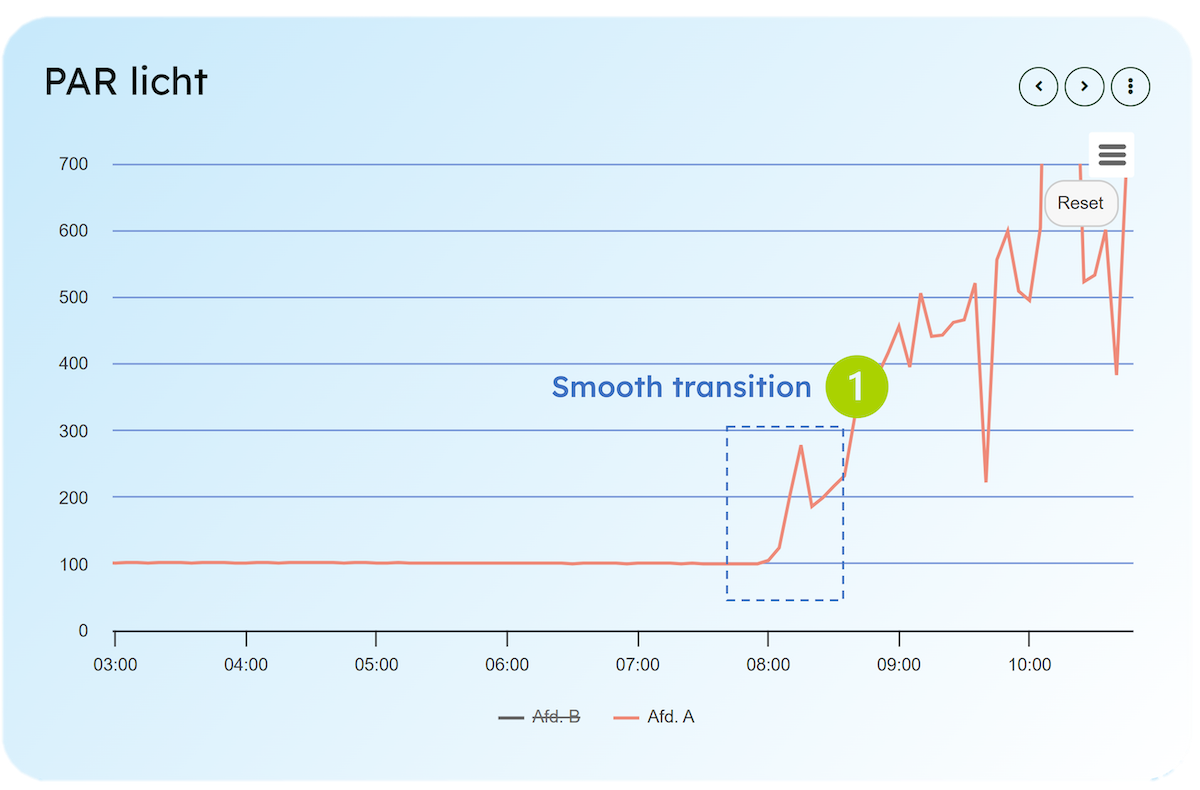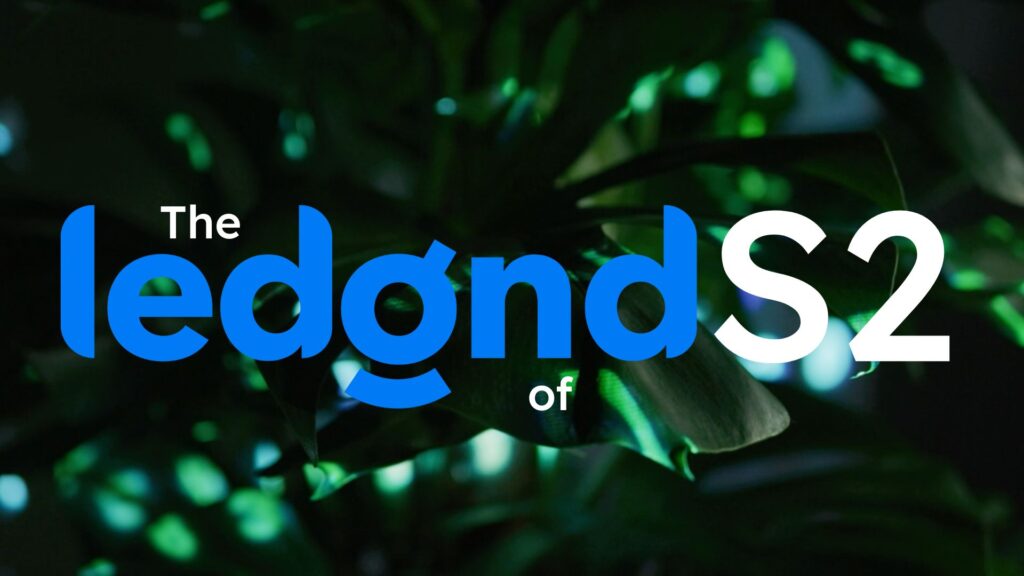Data from the Greenhouse: PAR
In this article, we focus on Photosynthetically Active Radiation (PAR), a crucial factor for crop growth. PAR describes the amount of light available for photosynthesis, measured in micromoles of photons per square meter per second (µmol/m²/s). The data is sourced from a PAR sensor placed just above the crop.
In our ‘Data from the Greenhouse’ series, we showcase the possibilities of using greenhouse data. Through practical examples, we explain how data analysis can provide deeper insights into your crops and climate. We offer you tools like MyLedgnd to analyze and interpret your own data. In this article, we discuss an example of the PAR from a chrysanthemum grower.
What is PAR?
PAR, or Photosynthetically Active Radiation, refers to the light that plants use for photosynthesis. This light falls within the wavelength range of 400 to 700 nanometers. Plants convert this light into energy through photosynthesis. PAR is essential for the growth and development of plants because it directly influences the amount of energy available for biomass production and growth processes. Measuring PAR values in a greenhouse gives growers insight into the amount of light that actually reaches the crop.
Analysis of PAR Value

Graphic 1
The graph above shows the fluctuation of PAR over a 24-hour period. You can clearly see the difference between the hours when LED lighting is used and the hours when the crop is exposed to natural sunlight. The LED lighting starts at 23:00 and stops around 8:00 (number 1), after which the crop is further illuminated by the sun.
Lighting efficiency: The initial phase

Graphic 2
Key observations graphic 2:
– At 23:00, the assimilation lighting (LED lighting) is abruptly turned on.
– Around 8:00, we observe the transition from artificial to natural lighting.
Zooming in on July 24 and 25, we see that on July 24 at 23:00(number 1), the LED lighting is turned on at full intensity. The light immediately jumps from 0 to 40 PAR. This raises questions about efficiency because plants need time to adjust to changes in light conditions. This means that plants do not immediately benefit from the full light intensity. As a result, the first few minutes when the lights are on are less efficient since the plant is not yet optimally prepared to use the light effectively, causing energy to be wasted.
Our recommendation is to consider gradually increasing the lighting, allowing the plant to be exposed to the full intensity less abruptly. A stepwise increase in lighting, for example by gradually increasing the lamps’ intensity over the course of an hour, can help the plant make better use of the energy and improve growth efficiency.
Dynamic dimming: Cost efficiency vs. Crop optimization

Graphic 3
On July 25, in graphic 3, we can clearly see two dips (number 1) in the amount of PAR light. These dips are caused by a dynamic lighting policy. In this case, the grower controls the lights based on energy prices. Once the price exceeds a certain threshold, the lamps are dimmed to save costs.
From an economic standpoint, this is a logical strategy, but it has a suboptimal effect on crop growth. Plants need a constant amount of light to grow optimally. Sudden changes in light intensity can reduce light utilization efficiency, resulting in missed growth potential.
However, finding the right balance between energy costs and crop yield remains a challenge for growers. Our advice is to closely monitor the impact of this strategy. By comparing energy cost savings with potential growth losses, an optimized strategy can be developed that is both economically and agronomically sound.
Transition from artificial to natural lighting

Graphic 4
In image 4, we see that at 8:00 (number 1), the LED lighting is abruptly switched off and the screens are opened. This causes the crop to immediately transition from artificial lighting to natural sunlight. For a short period, this can result in insufficient light reaching the crop because the sun may not yet be strong enough to provide the crop with the necessary light. This abrupt change can also cause stress in the plant, negatively affecting photosynthesis.
Smooth transition from artificial to natural light

Graphic 5
In one of the measurements, we see a smooth transition in figure 5 from LED light to natural light, where the grower switches off the lights and immediately opens the screens at 8:00 (number 1). Although this worked well in this case, it is often a matter of chance. If the natural light intensity is not sufficient when the lights are turned off, it can still cause stress for the crop.
To structurally prevent such stress moments, we recommend a dynamic system based on external radiation. This means that the assimilation lighting remains on until natural light has reached a certain threshold. This ensures that the transition to natural light always occurs smoothly, regardless of weather conditions. Such an approach creates a consistent growth environment for the crop and prevents unexpected fluctuations in light availability.
Advice and cultivation strategy from Ledgnd
Based on the above analysis, we have formulated the following recommendations for this case:
1. Gradual startup of LED lighting
Avoid turning on the full light intensity all at once. Gradually increasing the lighting allows the plant to use the light more efficiently, reducing stress and minimizing energy waste.
2. Dynamic lighting policy
While dynamic dimming based on energy costs offers benefits, it can lead to suboptimal growth. It is important to find the right balance between cost savings and crop yield. Continuous monitoring and adjustment based on cultivation results are essential in this process.
3. Smoother transition between lighting sources
Avoid abrupt transitions from assimilation lighting to natural light by keeping the lighting on longer or opening the screens earlier. A dynamic system based on external radiation can further optimize this process.
4. Use of sensors
Accurately measuring PAR values with sensors above the crop provides valuable information about the light environment. You can use this data to further refine your lighting strategy, for example by adjusting the duration and intensity of lighting based on external conditions.
Conclusion
Optimizing PAR lighting in the greenhouse is crucial for both crop yield and energy costs. By focusing on gradually increasing lighting, dynamically adjusting lighting duration based on energy costs, and ensuring a smooth transition between artificial and natural lighting, growers can refine their strategy for a better balance between cultivation results and costs.
New articles

How 2025 became the year of plant feedback, sustainability and collaboration
2025 was a year of contrasts for many growers: rising costs and stricter regulations, while at the same time more opportunities than ever to gain control of the crop using data. At Ledgnd, the year wa…

“From pioneering to professionalising”, Matthea Rijneker reflects on her first six months as CEO of Ledgnd
At Ledgnd, 2025 was a year of change. Not only within the MyLedgnd platform, but also within the organisation itself, which went through a clear strategic shift. Midway through the year, Matthea stepp…

Ledgnd launches season 2 of video series “The Ledgnd of”
Ledgnd has launched the second season of its video series “The Ledgnd of”. The series takes a closer look at the key concepts and innovations shaping modern greenhouse horticulture. In the new season,…
Read more

How 2025 became the year of plant feedback, sustainability and collaboration
2025 was a year of contrasts for many growers: rising costs and stricter regulations, while at the same time more opportunities than ever to gain control of the crop using data. At Ledgnd, the year wa…

“From pioneering to professionalising”, Matthea Rijneker reflects on her first six months as CEO of Ledgnd
At Ledgnd, 2025 was a year of change. Not only within the MyLedgnd platform, but also within the organisation itself, which went through a clear strategic shift. Midway through the year, Matthea stepp…

Ledgnd launches season 2 of video series “The Ledgnd of”
Ledgnd has launched the second season of its video series “The Ledgnd of”. The series takes a closer look at the key concepts and innovations shaping modern greenhouse horticulture. In the new season,…
Do you want to know more?
Interested in what Ledgnd can do for you? Leave your phone number, and we will contact you as soon as possible for a non-binding informational conversation

